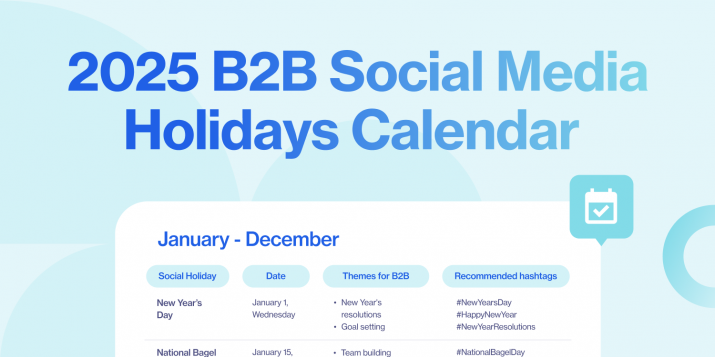
5 Social Media Skills College Doesn’t Teach You
College is important, we know. But the theoretical approach to learning isn’t always relevant or practical enough for the real world, and certainly not for marketers. Social-savvy and trend-driven may be the basic social media skills, but these are no longer enough to master the field. As social channels continue to evolve, so do the skills required to truly succeed in this role – and climb beyond it.
But what are these social media skills exactly and how can you work on them? In this post, we offer some answers:
1. Think Bigger than Your Role
Understanding the company’s business goals – and how they’re connected to your efforts – is just as important as understanding what to share on Facebook and LinkedIn. With social media being the third-largest channel used by potential customers to learn about a company’s products or services, every post you generate can turn into a business opportunity.
A lead who clicked on a webinar post can convert into a qualified prospect, and in turn, bring revenue. This means that you control a channel with a direct impact on the company’s bottom-line. Big responsibility, right? That’s why aligning your social media strategy with the company’s business goals is no longer a task you can afford to ignore.
Through the lens of social media, the term “business goals” refers to “business metrics” like traffic, leads, conversions, lead-to-revenue, and so on. This is very different from simple “performance metrics”, which analyze the audience engagement around your content by tracking likes, shares, comments, retweets, etc.
Being an A-list social media manager means you’re able to clearly understand both metric types – and tie the two together for an overall picture of how your social content is driving business value. For example, if your goal is to drive lead conversions, you must implement a tool to attribute these conversions back to social channels and your efforts.
Sitting with your manager to set these clear metrics and reporting systems will allow you to easily demonstrate the contribution of social to sales, and ultimately, to revenue.
2. Be Camera-ready
Video trends come and go, but confidence is a long-lasting trait.
As a social media manager, you not only own the company’s most important online presence, you’re also the face of it. At one point or another, you’ll have to step into the limelight and share your own views to the camera.
Whether you interview your CEO for a LinkedIn video, give a talk about your company’s latest innovations, chat with your followers, or go live at an event, be prepared to brush up your public speaking skills and represent your company.
As an engagement tactic, companies are looking to humanize their brand voice by revealing the people behind it. So while it may be daunting at first, leverage this opportunity to share your insights on the digital stage and grow professionally.
Recommended for further reading
3. Develop Your Customer-Facing Skills
How many times have you encountered a problem with a product or service? At such a frustrating point, would you rather wait for someone to answer at a call-center or post your question directly to the company’s Facebook page?
Nearly 70% of consumers said that they have used social media for customer service issues. Another interesting fact is that 88% of consumers are less likely to buy from a company that leaves complaints on social media unanswered.
Customers have come to expect support on social media, and companies that can’t provide it will be perceived as a dinosaur with an F in customer experience. To be an all-star social media manager, you must master the basics of social customer care.
This involves being empathetic, personable, and speedy when customers approach you with questions or feedback. Depending on the conversion, you’ll either have the knowledge to provide a sufficient response or get an appropriate representative involved.
For example, a question relating to pricing deserves a response from a salesperson. In order to deliver authentic and personal customer interactions, it’s important to understand the limits of your expertise and assign the right question to the right employee in your company.
4. Be Prepared to Handle Any Crisis
Social media is like the magic mirror used by the evil queen in Snow White – it will always reflect the truth.
But unlike the mirror in Snow White, the truth on social media is revealed to everyone, worldwide. From sending the wrong email campaign to your website crashing, crises of any type could break out at any moment. And when they do, prospects or customers can easily turn to social media to express their discontent.
Quite frankly, not every negative comment calls for company-wide action. So if or when a crisis hits, make sure to assess the following signs:
- Information asymmetry – when the public knows more (than your company) about the issue and they voice it on social. That’s your first sign of a social media crisis.
- A change from the norm – a few critical product reviews are noise, not a crisis. But when there’s a series of public outcries, different from the ordinary, that’s your second sign of a social media crisis.
- Dramatic impact on the company – the magnitude of the crisis is also important to acknowledge. Whether it’s deteriorating your reputation or driving customers to churn, a true ‘crisis’ must have a noticeably negative effect on your company.
If your company is experiencing a social media crisis, as described by the above signs, you should be ready to cool down the fire! Monitoring the environment for a potential crisis as well as preventing a crisis when it occurs, and communicating it to the company, are all capabilities that will take you from plain “good” to “fabulous”.
For more information on how to tackle any social crisis, check out this comprehensive guide to social media crisis management.
5. Get Your Brand On
Branding and social media marketing seem like worlds apart. But in fact, the two go hand-in-hand.
Branding and social media marketing seem like worlds apart. But in fact, the two go hand-in-hand. Click To Tweet
Every time you post a tweet, run a poll, or update your cover photo, your company showcases its brand voice – visually or verbally. Hence, the company’s brand guidelines should determine which content you create, which social platforms you use, and which audiences you target. Start by looking at these:
- Values: Every piece of content you create needs to fit with your brand’s core values. If your company culture is deeply rooted in being data-driven, then everything you write should be backed up by numbers. Similarly, if it’s all about customer-centricity, include customer quotes raving about your service. Don’t be afraid to experiment with your brand’s tone on each platform: it can be more serious in LinkedIn, witty on Twitter, and inspirational on Instagram, for example.
- Visuals: Logos, mascots, photography, and iconography are all visual references to your brand. To make it easier for your audience to recognize and distinguish you from competitors, make sure to brand your imagery according to the company’s colors and style guide. But the brand isn’t all about logos and colors, it’s also about conveying emotions. For example, an old law firm could feature stock photos with subjects wearing corporate suits, whereas a startup would need vibrant, authentic imagery to reflect its young spirit.
- Personality: Think of your brand personality as the language that guides both verbal and visual content. As with any language, it will no doubt change and evolve as your organization evolves. A budding startup that went on to become a NASDAQ giant will adjust its messaging and branding as it grows. You too shouldn’t be afraid to align your branding with the rhythm of the company’s growth.
- Consistency: It’s possible that customers follow your company on several channels, so delivering a consistent message is critical. While tweaking your content to fit the respective platform is good practice, changing the values, visuals, and personality of your company on each social network is not.
The New Social Media Manager
As Facebook, LinkedIn, Twitter, YouTube and more take center stage and are embraced by buyers and customers alike, social media managers need to constantly adapt their skillset. If 5 years ago you were only expected to be a natural-born writer, today you’re also expected to be a branding manager, a crisis manager, and a customer care rep.
To be awesome at all roles, flexibility and agility need to become your mantras. Mastering social media skills you never thought you would use is also key. Make sure you check every box by reading our latest Social Media Checklist to guide your daily, weekly, monthly, and quarterly activities!











